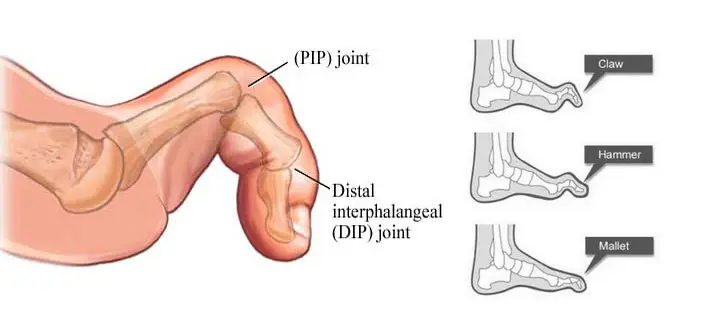Hammertoes Treatment in New Jersey
The Foot & Ankle Center
at Modern Orthopedics of New Jersey
Paramus
72 Route 17 North
Paramus, NJ 07652
Wayne
2025 Hamburg Turnpike
STE C, Wayne, NJ 07470
Parsippany
3799 US-46
#207, Parsippany, NJ 07054
Hammertoes
A hammertoe is a deformity in the second, third, or fourth toes. Initially, hammertoes may be flexible, meaning the affected toe can still be straightened manually. Over time, the tendons, ligaments and capsular structures may tighten, making the deformity rigid and more difficult to correct without intervention.
Treatment options for hammertoe range from conservative measures such as wearing properly fitting footwear, using orthotic inserts, and performing toe exercises to surgical interventions in severe cases. Surgery aims to realign the toe joint, remove any bone abnormalities, and correct the deformity, providing relief from pain and restoring function to the affected toe. Early diagnosis and appropriate management are key to preventing further complications associated with hammertoes.
Importance of seeking treatment for hammertoes
Seeking treatment for hammertoes is crucial to preventing further complications, such as chronic pain, difficulty walking, and skin ulcers. Early intervention can help alleviate discomfort, improve mobility, and halt the progression of the deformity. Ignoring hammertoe symptoms may lead to permanent stiffness in the toe joint, making it harder to correct later on. Proper treatment, which may include lifestyle changes, orthotic devices, or surgery, can enhance the quality of life and prevent the need for more invasive procedures in the future. Therefore, it’s essential to consult a healthcare professional for timely diagnosis and personalized treatment.
Understanding Hammertoe
Definition of Hammertoe
Hammertoe is a foot deformity that can affect any toe of the foot. It’s characterized by an abnormal bending of the toe joint, causing the toe to resemble a hammer or claw. This condition can result from various factors, including wearing ill-fitting shoes, muscle imbalance, arthritis, or genetic predisposition.
Common symptoms of hammertoe include pain, swelling, corns, calluses, and difficulty moving the affected toe. These symptoms might worsen with time and can significantly impact mobility and comfort.
Types of Hammertoe
Flexible Hammertoe
Rigid Hammertoe
Over time, if left untreated, flexible hammertoe can progress to become rigid. In this stage, the toe joint becomes fixed in its bent position, making it challenging to straighten manually. Rigid hammertoe may require more aggressive interventions, such as surgery to correct the deformity.
Mallet Toe
Claw Toe
Symptoms of Hammertoe
Hammertoe typically presents with symptoms such as:
- Abnormal bending of the toe joint, resembling a hammer or claw, as mentioned above
- Pain or discomfort in the affected toe, especially when wearing shoes or walking
- Swelling and inflammation around the affected joint
- Corns or calluses on the top or tip of the toe caused by friction and pressure from footwear
- Difficulty moving the affected toe or straightening it manually, particularly in advanced stages
- Redness or irritation at the toe joint

Causes and Risk Factors
Common Causes of Hammertoe
Hammertoe can develop due to various factors, including:
Improper Footwear
Genetic Predisposition
Muscle and Tendon Imbalances
Trauma
Arthritis
Factors that Increase the Risk of Developing Hammertoe
Several factors can increase the risk of developing hammertoe:
Foot Structure
Genetics
Age
Footwear
Occupation
Medical Conditions
Toe Length Discrepancy
Previous Foot Injuries
Diagnosis of Hammertoe
Methods Used for Diagnosing Hammertoe
Diagnosing hammertoe typically involves a combination of medical history review, physical examination, and sometimes imaging studies. Here are the methods commonly used:
Medical History Review
- They may also ask about risk factors such as footwear choices and any family history of foot problems.
Physical Examination
Manipulation Test
X-Rays
Based on the findings from these diagnostic methods, the healthcare provider can determine the appropriate treatment plan for managing hammertoe effectively.
Importance of Seeking Medical Evaluation
Seeking medical evaluation for hammertoes is essential as it allows for a comprehensive assessment of the condition’s impact on foot health and overall well-being. A professional diagnosis aids in tailoring treatment plans to address specific needs, whether through conservative measures, such as orthotic devices and exercises, or surgical intervention when necessary. Additionally, early detection can prevent complications like chronic pain, skin ulcers, and mobility limitations, promoting long-term foot health and minimizing the need for more invasive procedures in the future.
Non-Surgical Treatment Options for Hammertoe
Orthotic Devices and Footwear Modifications
Orthotic devices and footwear modifications play vital roles in managing hammertoes. Orthotics, such as toe spacers or pads, can help alleviate pressure on affected toes, reducing pain and preventing further deformity progression. Custom-made orthotic inserts may also correct foot alignment issues contributing to hammertoes. Footwear modifications involve wearing shoes with wider toe boxes to accommodate toe deformities and minimize friction. Choosing shoes with low heels and adequate arch support can promote proper foot alignment and reduce strain on the toes. Combined with other treatments, orthotic devices and footwear modifications offer effective support, comfort, and stability for individuals with hammertoes.
Toe Exercises and Stretches
Toe exercises and stretches involve movements like toe curls, toe extensions, and towel scrunches to strengthen and stretch the toe muscles and tendons, enhancing flexibility and reducing stiffness. While they can provide temporary pain relief and improve toe function, they do not correct the underlying structural deformity of hammertoes.
Pain Management Techniques
Pain management techniques for hammertoes include over-the-counter pain relievers, topical creams, pads to cushion affected toes, and ice packs to reduce inflammation. Proper footwear, orthotic inserts, and toe splints may also alleviate discomfort. In severe cases, corticosteroid injections or surgery may be recommended for long-term pain relief.
Surgical Treatment Options for Hammertoe
Overview of Surgical Procedures for Hammertoe
Surgical procedures for hammertoe aim to correct the deformity, relieve pain, and restore the toe function. Common techniques include:
Flexor Tenotomies
Arthroplasty
Arthrodesis
Tendon Transfer
Joint Resection
Implant Placement
Osteotomy
These procedures are typically performed on an outpatient basis under local anesthesia. Recovery time varies, but patients may need to wear a special shoe, boot and/or splint temporarily.
Potential Risks and Benefits of Surgery
Hammertoe surgery offers potential benefits such as correcting toe deformity, relieving pain, and improving toe function and appearance. Patients may experience increased comfort, enhanced mobility, and reduced reliance on special footwear post-surgery.
However, surgery also carries risks, including infection, bleeding, nerve damage, and stiffness. Additionally, there’s a possibility of recurrence or incomplete correction of the deformity.
Recovery time varies and some patients may require physical therapy to regain strength and flexibility. Thorough preoperative evaluation and discussion with a healthcare provider are essential to weigh the potential risks against the benefits and determine the most suitable treatment approach for each individual.
Complications of Untreated Hammertoe
Possible Complications of Leaving Hammertoes Untreated
Leaving hammertoe untreated can lead to various complications, including:
Chronic Pain
Recurrent Corns and Calluses
Limited Mobility
Skin Ulcers
Contracture
Interference With Foot Function
Early intervention and appropriate treatment are crucial to prevent these complications and effectively manage hammertoe.
Preparing for a Medical Appointment
Steps to Take Before Visiting a Healthcare Provider
Before visiting a healthcare provider for hammertoe evaluation, consider taking the following steps:
Self-Assessment
Footwear Evaluation
Pain Management
Toe Exercises
Foot Care
Documentation
Questions
By taking these steps, you can provide valuable information to the healthcare provider and actively participate in the evaluation and management of your hammertoe condition.
Questions to ask during the appointment
During your appointment for hammertoe evaluation, consider asking the following questions:
- What is causing my hammertoe, and what factors may be contributing to its development?
- What are the treatment options available for my hammertoe, and which do you recommend for my specific situation?
- What are the potential risks and benefits associated with each treatment option?
- How will the chosen treatment alleviate my symptoms and improve my foot function?
- What is the expected recovery time, and what steps can I take to promote healing?
- Are there any lifestyle modifications or exercises that can help manage my hammertoe?
- Will I need follow-up appointments, and how will my progress be monitored?
- What should I do if I experience worsening symptoms or complications after treatment?
- Are there any long-term implications or precautions I should be aware of regarding my hammertoe?
- Are there any other healthcare professionals I should consult as part of my treatment plan?
These questions can help you gain a better understanding of your condition, treatment options, and prognosis, empowering you to make informed decisions about your foot health.




A Different Orthopedic Experience.
We combine cutting-edge technology with personalized care to deliver exceptional orthopedic treatment. Our team of experts focuses on your unique needs to ensure optimal outcomes and a superior healing experience.
Our Approach to Care
Comprehensive solutions for your orthopedic needs
Treatment Diversity
We offer a comprehensive range of treatments, ensuring personalized, targeted plans for every patient.
Technological Excellence
We utilize cutting-edge technology for precise diagnosis and innovative treatment options.
Collaborative Care
Our multi-disciplinary approach involves various specialties to provide comprehensive care and recovery.
Skilled Experts
Our team is composed of highly skilled, experienced orthopedic professionals, providing expert care.
Patient Focus
We prioritize patient comfort and satisfaction, creating a supportive environment for optimal healing.
Post-Treatment Support
Our robust post-treatment support ensures ongoing patient care through recovery and rehabilitation services.